David Burth Kurka
DeepJSCC-Q: Constellation Constrained Deep Joint Source-Channel Coding
Jun 16, 2022

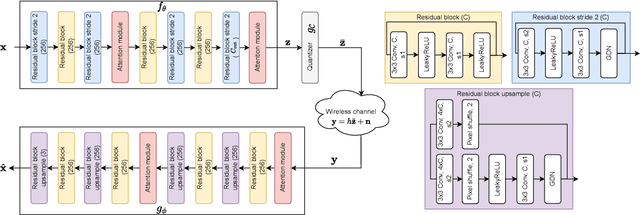

Abstract:Recent works have shown that modern machine learning techniques can provide an alternative approach to the long-standing joint source-channel coding (JSCC) problem. Very promising initial results, superior to popular digital schemes that utilize separate source and channel codes, have been demonstrated for wireless image and video transmission using deep neural networks (DNNs). However, end-to-end training of such schemes requires a differentiable channel input representation; hence, prior works have assumed that any complex value can be transmitted over the channel. This can prevent the application of these codes in scenarios where the hardware or protocol can only admit certain sets of channel inputs, prescribed by a digital constellation. Herein, we propose DeepJSCC-Q, an end-to-end optimized JSCC solution for wireless image transmission using a finite channel input alphabet. We show that DeepJSCC-Q can achieve similar performance to prior works that allow any complex valued channel input, especially when high modulation orders are available, and that the performance asymptotically approaches that of unconstrained channel input as the modulation order increases. Importantly, DeepJSCC-Q preserves the graceful degradation of image quality in unpredictable channel conditions, a desirable property for deployment in mobile systems with rapidly changing channel conditions.
Augmenting Novelty Search with a Surrogate Model to Engineer Meta-Diversity in Ensembles of Classifiers
Feb 08, 2022



Abstract:Using Neuroevolution combined with Novelty Search to promote behavioural diversity is capable of constructing high-performing ensembles for classification. However, using gradient descent to train evolved architectures during the search can be computationally prohibitive. Here we propose a method to overcome this limitation by using a surrogate model which estimates the behavioural distance between two neural network architectures required to calculate the sparseness term in Novelty Search. We demonstrate a speedup of 10 times over previous work and significantly improve on previous reported results on three benchmark datasets from Computer Vision -- CIFAR-10, CIFAR-100, and SVHN. This results from the expanded architecture search space facilitated by using a surrogate. Our method represents an improved paradigm for implementing horizontal scaling of learning algorithms by making an explicit search for diversity considerably more tractable for the same bounded resources.
DeepJSCC-Q: Channel Input Constrained Deep Joint Source-Channel Coding
Nov 25, 2021


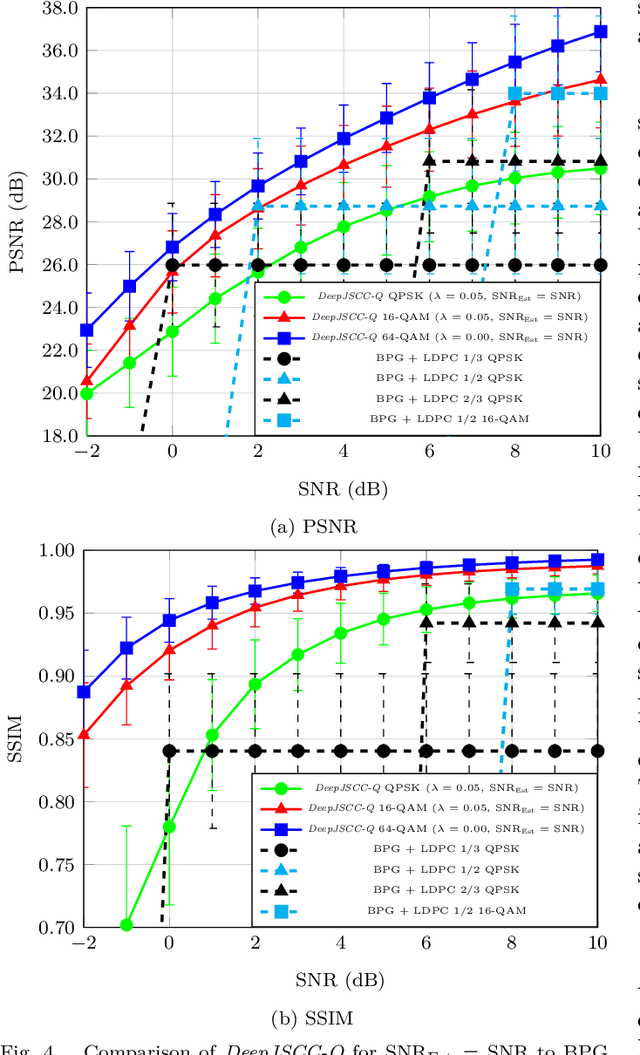
Abstract:Recent works have shown that the task of wireless transmission of images can be learned with the use of machine learning techniques. Very promising results in end-to-end image quality, superior to popular digital schemes that utilize source and channel coding separation, have been demonstrated through the training of an autoencoder, with a non-trainable channel layer in the middle. However, these methods assume that any complex value can be transmitted over the channel, which can prevent the application of the algorithm in scenarios where the hardware or protocol can only admit certain sets of channel inputs, such as the use of a digital constellation. Herein, we propose DeepJSCC-Q, an end-to-end optimized joint source-channel coding scheme for wireless image transmission, which is able to operate with a fixed channel input alphabet. We show that DeepJSCC-Q can achieve similar performance to models that use continuous-valued channel input. Importantly, it preserves the graceful degradation of image quality observed in prior work when channel conditions worsen, making DeepJSCC-Q much more attractive for deployment in practical systems.
Communicate to Learn at the Edge
Sep 28, 2020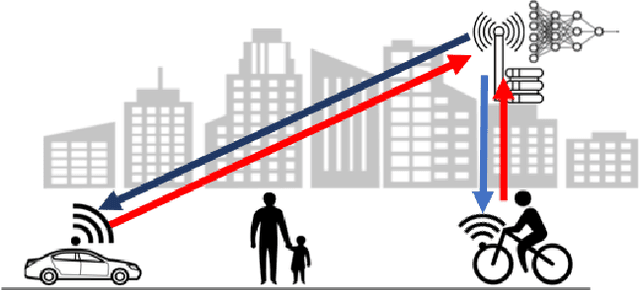
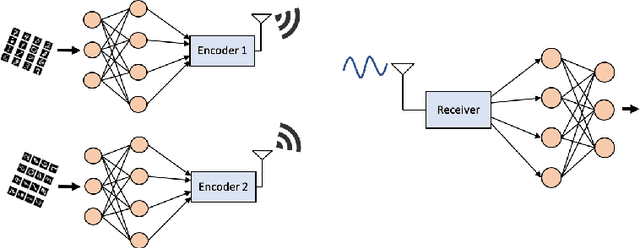
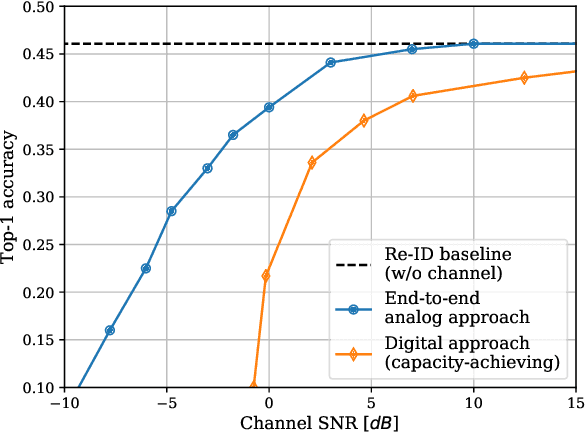
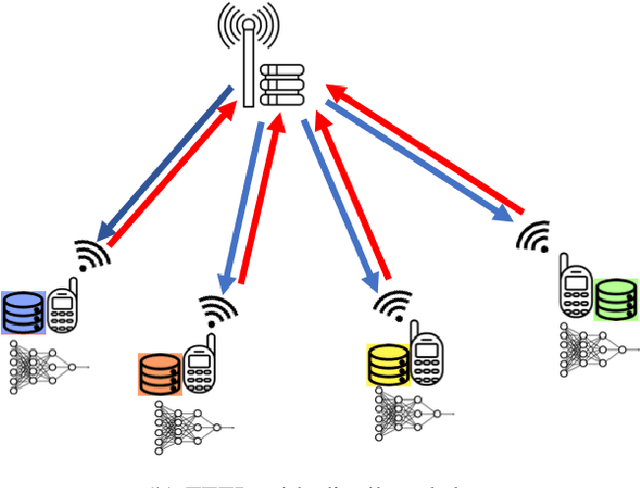
Abstract:Bringing the success of modern machine learning (ML) techniques to mobile devices can enable many new services and businesses, but also poses significant technical and research challenges. Two factors that are critical for the success of ML algorithms are massive amounts of data and processing power, both of which are plentiful, yet highly distributed at the network edge. Moreover, edge devices are connected through bandwidth- and power-limited wireless links that suffer from noise, time-variations, and interference. Information and coding theory have laid the foundations of reliable and efficient communications in the presence of channel imperfections, whose application in modern wireless networks have been a tremendous success. However, there is a clear disconnect between the current coding and communication schemes, and the ML algorithms deployed at the network edge. In this paper, we challenge the current approach that treats these problems separately, and argue for a joint communication and learning paradigm for both the training and inference stages of edge learning.
Bandwidth-Agile Image Transmission with Deep Joint Source-Channel Coding
Sep 26, 2020



Abstract:We introduce deep learning based communication methods for adaptive-bandwidth transmission of images over wireless channels. We consider the scenario in which images are transmitted progressively in discrete layers over time or frequency, and such layers can be aggregated by receivers in order to increase the quality of their reconstructions. We investigate two scenarios, one in which the layers are sent sequentially, and incrementally contribute to the refinement of a reconstruction, and another in which the layers are independent and can be retrieved in any order. Those scenarios correspond to the well known problems of successive refinement and multiple descriptions, respectively, in the context of joint source-channel coding (JSCC). We propose DeepJSCC-$l$, an innovative solution that uses convolutional autoencoders, and present three different architectures with different complexity trade-offs. To the best of our knowledge, this is the first practical multiple-description JSCC scheme developed and tested for practical information sources and channels. Numerical results show that DeepJSCC-$l$ can learn different strategies to divide the sources into a layered representation with negligible losses to the end-to-end performance when compared to a single transmission. Moreover, compared to state-of-the-art digital communication schemes, DeepJSCC-$l$ performs well in the challenging low signal-to-noise ratio (SNR) and small bandwidth regimes, and provides graceful degradation with channel SNR.
DeepJSCC-f: Deep Joint-Source Channel Coding of Images with Feedback
Nov 25, 2019



Abstract:We consider wireless transmission of images in the presence of channel output feedback. From a Shannon theoretic perspective feedback does not improve the asymptotic end-to-end performance, and separate source coding followed by capacity achieving channel coding achieves the optimal performance. Although it is well known that separation is not optimal in the practical finite blocklength regime, there are no known practical joint source-channel coding (JSCC) schemes that can exploit the feedback signal and surpass the performance of separate schemes. Inspired by the recent success of deep learning methods for JSCC, we investigate how noiseless or noisy channel output feedback can be incorporated into the transmission system to improve the reconstruction quality at the receiver. We introduce an autoencoder-based deep JSCC scheme that exploits the channel output feedback, and provides considerable improvements in terms of the end-to-end reconstruction quality for fixed length transmission, or in terms of the average delay for variable length transmission. To the best of our knowledge, this is the first practical JSCC scheme that can fully exploit channel output feedback, demonstrating yet another setting in which modern machine learning techniques can enable the design of new and efficient communication methods that surpass the performance of traditional structured coding-based designs.
Successive Refinement of Images with Deep Joint Source-Channel Coding
Mar 15, 2019



Abstract:We introduce deep learning based communication methods for successive refinement of images over wireless channels. We present three different strategies for progressive image transmission with deep JSCC, with different complexity-performance trade-offs, all based on convolutional autoencoders. Numerical results show that deep JSCC not only provides graceful degradation with channel signal-to-noise ratio (SNR) and improved performance in low SNR and low bandwidth regimes compared to state-of-the-art digital communication techniques, but can also successfully learn a layered representation, achieving performance close to a single-layer scheme. These results suggest that natural images encoded with deep JSCC over Gaussian channels are almost successively refinable.
Deep Joint Source-Channel Coding for Wireless Image Transmission
Sep 15, 2018



Abstract:We propose a joint source and channel coding (JSCC) technique for wireless image transmission that does not rely on explicit codes for either compression or error correction; instead, it directly maps the image pixel values to the real/complex - valued channel input symbols. We parameterize the encoder and decoder functions by two convolutional neural networks (CNNs), which are trained jointly, and can be considered as an autoencoder with a non-trainable layer in the middle that represents the noisy communication channel. Our results show that the proposed deep JSCC scheme outperforms digital transmission concatenating JPEG or JPEG2000 compression with a capacity achieving channel code at low signal-to-noise ratio (SNR) and channel bandwidth values in the presence of additive white Gaussian noise. More strikingly, deep JSCC does not suffer from the `cliff effect', and it provides a graceful performance degradation as the channel SNR varies with respect to the training SNR. In the case of a slow Rayleigh fading channel, deep JSCC can learn to communicate without explicit pilot signals or channel estimation, and significantly outperforms separation-based digital communication at all SNR and channel bandwidth values.
 Add to Chrome
Add to Chrome Add to Firefox
Add to Firefox Add to Edge
Add to Edge